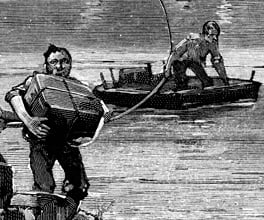Early exploration into Port Phillip
By the early 19th century settlements in both New South Wales and Tasmania had expanded dramatically. Settlers from both regions were worried that they were running out of grazing land.
In 1824, the explorers Hamilton Hume and William Hovell led an expedition from New South Wales to Corio Bay in Victoria (present-day Geelong). They crossed a large river, where Albury now stands, and named it the Hume River. It was later renamed the Murray River. Hume and Hovell would begin a bitter rivalry (mostly fought through letters and pamphlets) in the 1850s over their roles in the expedition. It was sparked by a report in The Argus which described Hovell declaring his:
...pleasure and pride in being the man who had discovered the country [...] twenty-nine years ago to be a wilderness, but which was now a thiving seat of civilisation, an infant nation capable of producing food to feed half the world, wool to clothe half the world, and gold to buy half the world.
- William Hovell
Hovell, W quoted in Scott, E 1921 Hume and Hovell's Journey to Port Philli,p D.S. Ford, Sydney, N.S.W.
The Henty family were the first Europeans to settle in Victoria’s Portland Bay. They had arrived from Van Diemen’s Land in 1834. Prior to their arrival, boats had worked along the coastline for many years hunting for whales and seals.
John Batman, representing the Port Phillip Association, and John Pascoe Fawkner arrived at the future site of Melbourne in 1835. They returned to Van Diemen’s Land with good news: the Port Phillip district was full of rich and fertile land, ideal for sheep and cattle.
What most European explorers and settlers could not see was the existing vegetation and how it was being continually harvested by Indigenous Australians. The value of many plants lay below the surface of the earth in their roots and tubers. Dr Beth Gott of Monash University has identified over 700 plant species that were used by Indigenous Australians. Plants like murrnong or 'yam-daisy' were ripped out of the ground by hungry sheep while other plants did not survive under the trampling hooves of livestock.
Major Thomas Mitchell was the Surveyor-General of New South Wales. He set out from Sydney in 1836 with the hope of tracing the course of the Murray River upstream from its junction with the Darling River.
After climbing Mount Pilot (just south of the Murray River), it was the substantial fertile lands to the south that captured his imagination. He ignored his official orders and took his expedition south through the Port Phillip district, naming the western plains 'Australia Felix'. In the Wimmera region he wrote:
Of this Eden I was the first European to explore its mountains and streams—to behold its scenery—to investigate its geological character—and, by my survey, to develop those natural advantages, certain to become at no distant date, of vast importance to a new people.
- Major Mitchell
Major Thomas Mitchell quoted in Kenny, R 2007, The Lamb enters the Dreaming, Scribe Publications, Carlton North, Vic.
Mitchell had a substantial expedition party of 30 men, including several Indigenous Australians from New South Wales who acted as guides and interpreters. The party's interactions with the different Indigenous groups whose land they were travelling through were mixed. One incident resulted in the killing of at least seven Indigenous Australians at Mount Dispersion.
They travelled with five bullock drays, a team of over 50 bullocks, a large cart carrying two boats and twelve horses. Mitchell also had a herd of sheep and some oxen as provisions:
This army left its mark: the cartwheels carved into the soft earth 'Mitchell’s Line', a trail which would remain visible into the twentieth century. But the mark upon the Aboriginal Australian societies proved more indelible.
- Robert Kenny
Kenny, R 2007, The Lamb enters the Dreaming, Scribe Publications, Carlton North, Vic.
Late in 1836, Mitchell’s party came across the Hentys at Portland Bay, to the surprise of both parties. When Mitchell eventually returned to Sydney, his positive reports of western Victoria led to a rush of settlers seeking new land.











